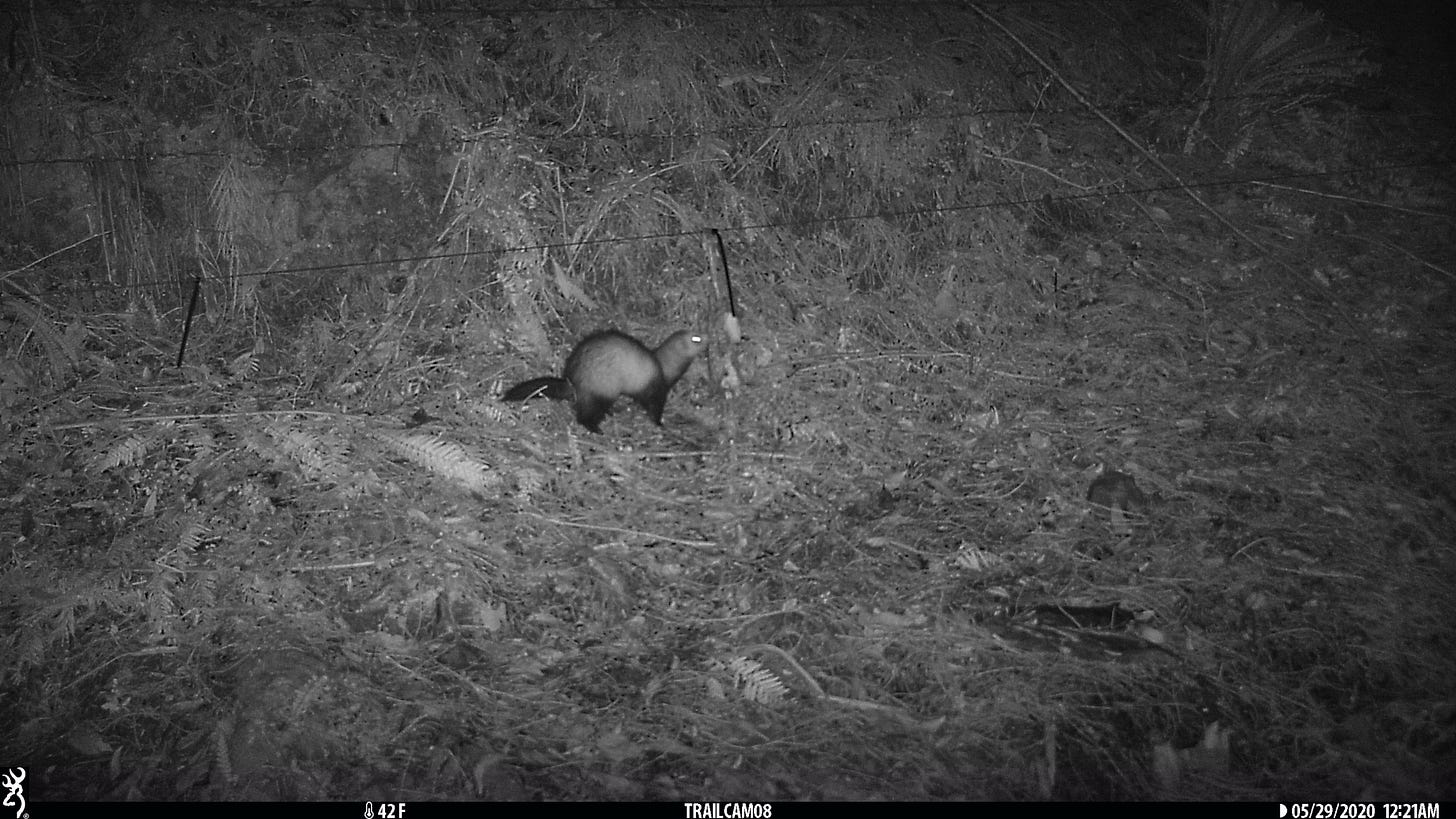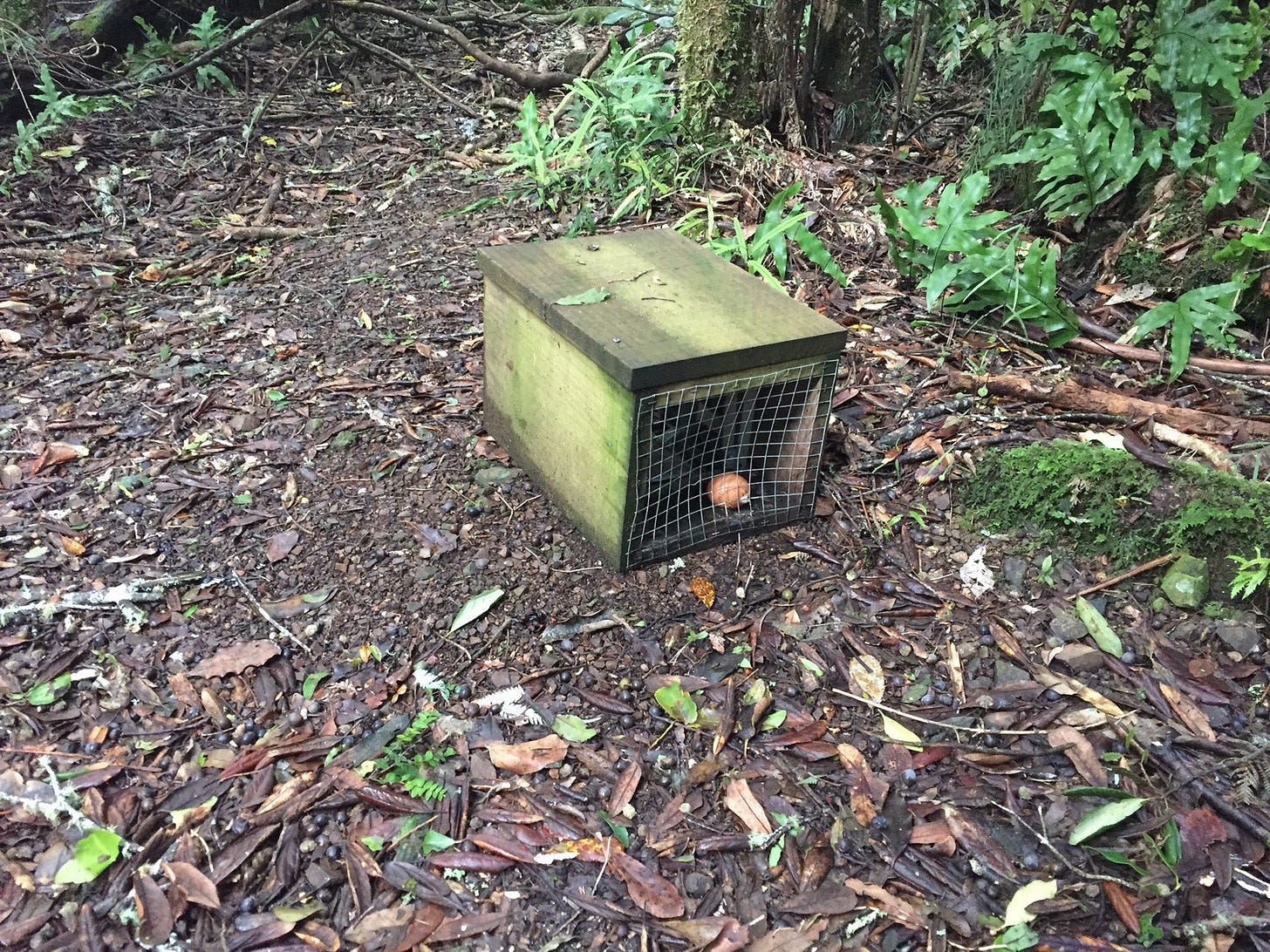Deadly trinity: part two
If you want to catch a ferret, you’ve got to think like a ferret
Many years ago, I attended a conference about the eradication and management of invasive species on islands. There, I heard a presentation about feral cat eradication. Although I don’t remember the speaker’s name, I do remember the message. Eradicating cats from islands, he said, required a real understanding of their behaviour, an understanding that, in the speaker’s case, had come from years as a hunter, trapping bobcats for their fur in the United States. He described it, succintly, in words that I still remember – “if you want to catch a bobcat, you’ve got to think like a bobcat”.
I’m reminded of that speaker when I talk with John Bissell, who is the National Predator Adviser with Kiwis for kiwi, and who also manages the predator control programme at Pūkaha, the National Wildlife Centre. Bissell is passionate about his work, and he speaks of bringing his experience as a hunter to the challenge of predator control at Pūkaha. He says that thinking like a ferret is not what he wants engraved on his headstone one day, but it certainly helps him now.
I’ve contacted Bissell to discuss mustelids – ferrets, stoats and weasels – at Pūkaha. As I mentioned in last week’s article, mustelids were introduced to New Zealand in the hope that they’d control rabbits. However, they had only a limited impact on the rabbit problem, and instead became a serious threat to New Zealand’s native birds, reptiles and insects.
The challenge with pest control at Pūkaha, Bissell tells me, is that the area is so productive. Once part of a rich forest that supplied the local Rangitāne people with abundant birds, fish and berries, these days Pūkaha “grows great birds and great rats”. Rats are a problem because they eat native birds and their eggs, but they are also an important food source for stoats. And so the more rats there are in the forest, the more stoats there are too.
How many mustelids there are at Pūkaha is far from certain, because they’re difficult animals to count. The most obvious way to figure out how many mustelids you have in an area is to trap them, and then count how many you catch in your traps, but that leaves the possibility that there are animals out there that don’t go near the traps. So Pūkaha has around 40 trail cameras supplementing the information coming from the traps. In the case of ferrets, the cameras give you a good idea of how many animals are present – Bissell can tell individual ferrets apart by their markings. With stoats, it’s more difficult. One stoat looks very like another, and they can travel long distances. Their home ranges can be larger than 100 hectares, and one stoat was recorded travelling 68 kilometres in 2 weeks. So when two cameras capture images of a stoat, you can’t be sure whether you’ve got two stoats, or just one that’s moving around.
Ferret caught on one of Pūkaha’s trail cameras: image courtesy of John Bissell, Backblocks Environmental Management
Mobility, therefore, is one reason that controlling mustelids is so difficult. To protect the birds living at Pūkaha requires nearly 4000 hectares of mustelid control – the 942 hectares of the reserve itself, and a 2700 hectare buffer zone on the surrounding farmland. And it’s not easy terrain either – the forest is dense and the land is steep. Usually, mustelids are controlled with traps laid out in a grid, but at Pūkaha they’ve been testing different approaches. Bissell reviewed years of data on trapping to see which traps were catching mustelids, and which were not. Then he took out some of the traps from areas where they weren’t catching anything, and put more in where they were. Such an approach could improve the cost effectiveness of trap network by directing effort to the areas where it’s most useful.
One of Pūkaha’s predator traps
Pukaha is also a great place to test new methods for predator control. Partly, Bissell tells me, this is because of the open attitude of the staff. Ever since Elwyn Welsh and his bantam hens raised four takahe chicks in 1960, Pūkaha has been a place for new thinking. The staff are interested in learning how they can do better. But partly, it’s the productivity of the forest, and the high pest levels it can support. “If you can control the pests at Pūkaha,” says Bissell, “you can control them anywhere.”
But all those traps, all those cameras and all that work can only achieve so much. As fast as the mustelids at Pūkaha are killed, they just as quickly reinvade from areas where they’re not being controlled. There’s no endgame when it comes to protecting our native birds. Any let up in pest control, and the predators come back. As I mentioned in last week’s article, that’s exactly what happened at Pūkaha during lockdown last year, and it resulted in the deaths of five kiwi.
One solution to prevent this reinvasion is to fence the reserve to keep mustelids out. I’ve written about predator fences before, when I talked about Zealandia and the return of kākā to Tarikākā in Wellington. Inside a fenced area, it is possible to remove predators completely and establish populations of birds too sensitive to survive anywhere else except a pest-free island. The success of Zealandia has encouraged the development of other fenced sanctuaries, including The Brook in Nelson and Maungatautari in Waikato. But predator fences are expensive – hundreds of dollars per metre – and protecting Pūkaha would require 21 kilometres of fence.
It wouldn’t be impossible to fence Pūkaha – the Maungatautari fence is 47 kilometres long, although that was build on much gentler terrain. But a fence is just the beginning. Once the fence is built, the pests inside have to be eradicated, and then the fence has to be maintained and monitored. If there is any breach in the fence, predators will quickly reinvade. While the fence is an effective way of protecting the species within, whether that protection is cost-effective is the subject of some debate.
The ultimate barrier to mustelids is not a fence, but a stretch of water. While it’s not an option for Pūkaha, of course, water protects many of our most important sanctuaries. Among the islands that have remained free from mustelids are Stewart Island, Hauturu (Little Barrier) and the Three Kings group. These islands are far enough from the mainland that there is no chance of mustelids arriving without them being deliberately introduced. But how far away is far enough?
Stoats, in particular, are good swimmers. By the 1980s, they had reached many islands within a kilometre of the mainland, but islands more than 1200 metres offshore were considered to be safe, as long as there were no other islands in between to act as stepping stones. However, in July 2010, there was an ominous discovery on Rangitoto Island. A year after a poison drop which was thought to have eradicated stoats, a single male was found on the island, even though there had been no other sign of stoats found since the poison drop. Had this individual evaded all the eradication and detection efforts? Had it swum from Waiheke Island, island-hopping via Motuihe and the tiny Papakohatu Island? Or had it swum from the mainland?
Genetic studies soon found the answer. The population of stoats that had existed on Rangitoto, and the adjoining Motutapu, prior to the poison drop was subtly but clearly distinct from both the mainland and Waiheke Island populations. The mainland and Waiheke populations of stoats were also distinct from each other. The single stoat that was found on Rangitoto a year after the poison drop matched mainland stoats. It was not related to the original Rangitoto population, or the Waiheke population. Either it had swum directly from the mainland, a distance of 3 kilometres, or it had swum via Browns Island, 2.6 kilometres from Rangitoto and 1.6 kilometres from the mainland.
More worrying news was to come. In the same year, stoats were found on Kāpiti Island. With no islands between Kapiti and the mainland, and no evidence that stoats ever stowed away on boats in the way rats do, that left the troubling conclusion that a stoat had somehow crossed 5.2 kilometres of water by itself. Subsequent research confirmed the swimming ability of stoats, suggesting that important conservation islands within 5 kilometres of the mainland needed permanent stoat monitoring. Another troubling conclusion was that stoats may be able to “raft” on floating debris – although this wasn’t reported for stoats, a ferret had been seen doing so.
Even on more distant islands, then, we cannot completely ignore the threat of mustelids. The survival of our native birds, reptiles and insects requires our constant vigilance, either controlling mustelids or monitoring in case they reach one of the areas that are currently free of them. But what if we didn’t have to? What if they could be eradicated from the whole of New Zealand?
Eradicating stoats from New Zealand is one of the goals of Predator Free 2050, an initiative that aims to protect New Zealand’s native species by completely removing rats, possums and stoats. It’s an ambitious goal indeed. So far, stoats have been eradicated from 42 islands, the largest of which is Rangitoto/ Motutapu, at just under 4000 hectares. It seems a long way from there to nationwide eradication. Is that goal realistic? What would it take? Those are questions that I will attempt to answer in a future article.
Did you enjoy this article? Subscribe now and a new article will be emailed to your inbox every Friday.
Let me know if you have any questions that you’d like me to answer through my articles. Or just let me know if you enjoyed the article.




